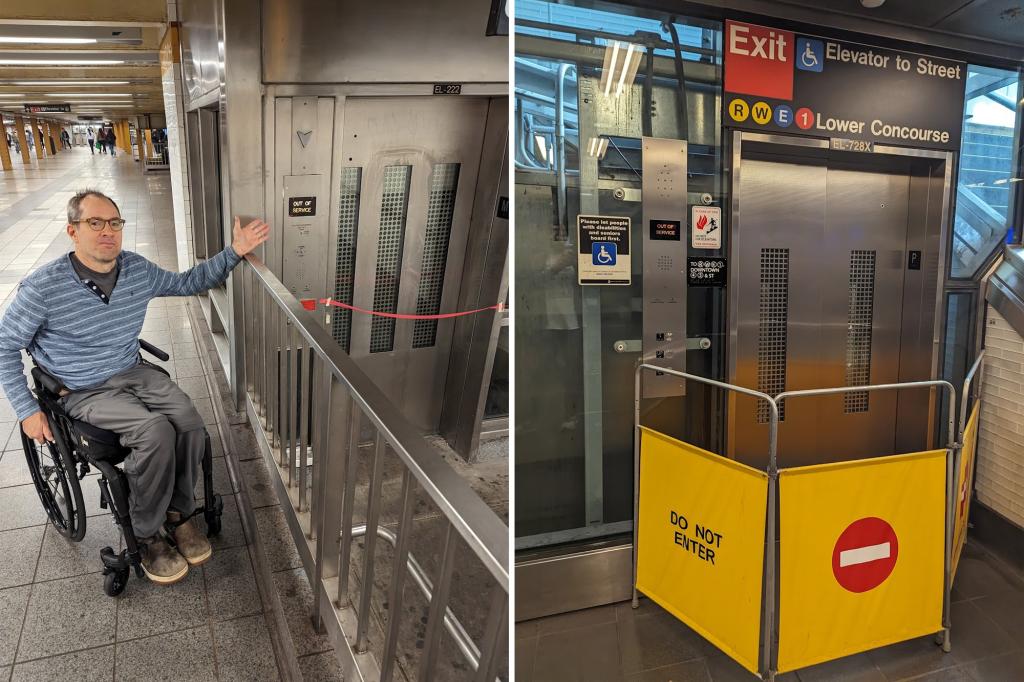The New York subway system is saddled with more than three dozen chronically broken elevators, but the MTA would rather fight activists suing to get them fixed than use the money to repair them, critics raged this week.
In the past week, 35 to 43 elevators were out of service on any given day, up to 13% of all elevators, including many at busy stations like Times Square and Union Square, according to the MTA’s elevator status page.
Yet the Metropolitan Transit Authority has spent millions of dollars and eight years fighting a federal class-action lawsuit brought by disabled New Yorkers over the broken lifts.
The suit, filed in April 2017 on behalf of three disabled New Yorkers, has seen more than 20 delays, six different judges, 11 lawyers hired by the MTA from four different private firms, 20 depositions, and more than 10,000 pages of motions.
The transit agency tried to have the case dismissed at least twice – once in 2021 when a federal appeals court ruled against them, and again in August when a Manhattan federal court judge disagreed.
“Your case is indefensible and a disgrace,” vented Jennifer Van Dyck of the Elevator Action Network at Wednesday’s MTA board meeting. “Eight years of legal fees is a waste of money, use these millions of dollars to fix the elevators – get it together, MTA.”
“All we want is an elevator that doesn’t break down. What do we have instead? Eight years of the MTA’s private lawyers earning seven figures,” chimed in Elevator Action Group organizer Jessica Murray.
The state has spent more than $3 million fighting the civil rights case, MTA records show. It has hired boutique law firm Hoguet Newman Regal & Kenney to represent it.
The court has ordered a settlement conference for May 28, but if an agreement can’t be reached, the case will likely head to trial.
The plaintiffs are not seeking money — they’re asking for a commitment from the MTA to have elevators that work, or at a bare minimum, a plan for when they don’t.
“It’s apparently too much to ask that the station agent know how to direct someone when an elevator is out of service,” said Murray, adding it takes the MTA as long as eight months to fix a single broken elevator.
“It’s not rocket science,” Sasha Blair-Goldensohn, a Google software engineer who uses a wheelchair and is one of the plaintiffs, told The Post. “It’s astounding that it’s taken this long. It’s deeply infuriating.”
Blair-Goldensohn lives on the Upper West Side, and for many years had to transfer at Columbus Circle to get to his job at Google in Chelsea. One of the elevators at that station has broken down 300 times over a four-year period, he estimates.
“I always have this anxiety – am I going to show up at an elevator and there’s going to be yellow tape across and a paper sign saying it’s not working.”
Blair-Goldensohn said the FDNY has had to be called to carry him up the stairs, or he’s had to reroute his trip by getting back on the subway — at least 100 times.
“This case should have settled a long time ago,” said Daniel Brown, the plaintiffs’ lawyer who’s worked on the case pro bono for law firm Sheppard Mullin. “It’s unfortunate it’s taken this long. It’s really about doing the right thing.”
The MTA settled a related case in 2022 where disability demanded more elevators in the subway system, arguing the Big Apple had one of the least accessible systems in the country. But advocates say there’s not much point in building more elevators if they’re always out of service.
The MTA said it’s quadrupled the pace of installations of elevators from five years ago — a result of the 2022 settlement. It said some elevator outages happen because of replacement projects.
“There’s never been a stronger commitment to accessibility in transit,” said MTA Chief Accessibility Officer Quemuel Arroyo.
Read the full article here

